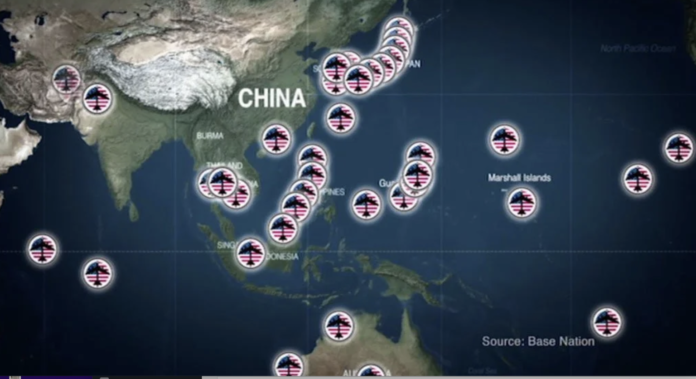This week, Australia and its AUKUS allies announced a plan to upgrade the Australian submarine fleet by buying up-to eight nuclear powered submarines, a deal estimated to cost $368 billion over the next thirty years.
This deal will enormously increase Australia’s naval power, and more importantly cements a long-term defence relationship between the AUKUS powers in the Pacific. It is a direct challenge to China’s naval build up in the region.
Why is the deal so important politically and militarily?
This deal is important for two reasons; first because it will vastly improve the capabilities of the Australian Navy and it alliance partners.
Secondly; because it raises the issue of nuclear proliferation because even though these submarines are nuclear powered; not nuclear armed there is the potential for nations outside of AUKUS to view this deal sceptically, as an escalation supporting nuclear proliferation.
Why Australia wants nuclear powered submarines
Nuclear submarines are the most powerful warships available to any navy. Silently, patrolling vast areas of ocean; they are very hard to find and can strike targets at considerable distances.
Speed and ability to deploy long distances quickly
Getting good open-source information about nuclear submarines is very difficult but we know that modern classes can maintain speeds of 25-30 knots underwater. Or approximately 45 – 55 km per hour and it is likely that they are actually faster; their speed means that they can deploy long distances very quickly and chase slower surface ships.
A variety of powerful weapons
Modern nuclear-powered submarines are large and complex weapons platforms boasting a range of weapons including torpedoes that can attack other submarines and ships; long-range anti-ship missiles like Harpoon, with a range of about 140km. And; Tomahawk cruise missiles that provide a long-range land attack capability, able to strike targets about 1,600km away.
Long-range surveillance
A little know asset of submarines is their surveillance capability. Sound travels very long distances through water and a submarine’s hydrophones can monitor activity for hundreds of kilometres (possibly thousands of kilometres) in all directions silently for long periods of time. If required their masts can be extended above the water to provide radar surveillance of the air space above them; or sonar can be used to track targets in the water although both these surveillance measures are active and could reveal the submarine’s position.
Ability to operate far from home without support
Another important attribute of a nuclear-powered submarine is their independence. Unlike an aircraft carrier, it does not require a protective escort and fleet of support ships carrying fuel for aircraft and other supplies. Likewise, conventionally powered submarines are very limited by their range and need to refuel. Instead, a nuclear submarine can deploy immediately and operate for long periods of time in the area of interest, without the need for a local base or constant resupply.
China does not yet have the military capability to defeat nuclear powered submarines
China has spent years building the capability to use long-range missiles to swamp the defences of an American carrier battle group. At present, a Chinese ‘Weapons Effect Zone’ is likely to be able to keep a carrier battle group at bay, however China does not have the capacity to ‘shut down’ submarine operations in the same manner; and by purchasing nuclear submarines Australia is gaining a capability that China cannot match.
Some historical examples provide good information about the capabilities of nuclear-powered submarines:
- The 1982 Falklands War is the only example of nuclear-powered submarines fighting in a conventional naval war. Two submarines, were the first British ships to arrive ‘on station’ in the South Atlantic where they quickly proceeded to find and monitor the two main Argentine task groups (including an aircraft carrier, two modern destroyers, five older warships and two submarines), then sink the Argentine cruiser ARA General Belgrano and drove the enemy fleet back into the safety of their home ports. Then they served as radar picquets, close to the Argentine coast providing early warning of air strikes against the British task force in the Falkland Islands.
- In both the 1991 and 2003 conflicts with Iraq, American and British submarines expended huge quantities of cruise missiles to attack land targets in Iraq. Tactically, submarine launched cruise missiles are often used to target air defence radar and control assets because they are very hard to detect. A plane launching a cruise missile is more likely to be spotted on radar than a submarine.
- During the War on Terror, Tomahawk missiles fired from nuclear powered submarines were used extensively against targets in Afghanistan. Looking on a map at how far Afghanistan is from the sea demonstrates the depth strike capability of Tomahawk missiles.
In simple terms, nuclear powered submarines are a modern navy’s ‘capital ship,’ the most important vessel in the fleet. Hence, why in the United States and Royal Navies their names are taken from the list of historic battleship names. And; like battleships they are the fleet’s most powerful strike asset able to dominate vast areas of ocean. Unlike a battleship though a nuclear-powered submarine is stealthy and can deploy long-distances very rapidly providing intelligence; and if required can immediately transfer to war-fighting operations.
The AUKUS purchase will give Australia a new and significant increase in naval capability. A level of capability currently only available to the United States, United Kingdom, France, China and Russia. It is a very big change to Australia’s naval capability.
Nuclear proliferation concerns
The 1968 Nuclear Non-proliferation Treaty aims to limit the spread of nuclear weapons and was negotiated by the United Nations, its mandate includes about 190 states.
The treaty allows for the transfer of nuclear materials between countries for peaceful purposes and although AUKUS worked closely with the International Atomic Energy Agency to demonstrate that the deal does not include weapons technology it has still been criticised, China’s UN delegation stating that “The nuclear submarine cooperation plan released today by AUKUS is a blatant act that constitutes serious nuclear proliferation risks, undermines the international non-proliferation system, fuels arms races, and hurts peace and stability in the region.”
Although Australia’s submarines will be nuclear powered; not nuclear armed the Chinese argue that this is an example of the United States and United Kingdom allowing the spread of nuclear materials and technology that could be used for weapons. And; although from a Western / NATO perspective the claim is laughable, it is important to remember that not all countries see the United Kingdom, United States and Australia as benevolent; and they are the countries that China’s protests are targeting.
James Acton from the Carnegie Endowment for International Peace summed up the situation very clearly stating that “My fear was never that Australia would misuse that fuel, but that other countries would invoke AUKUS as a precedent for removing nuclear fuel from safeguards.”
How the programme will be delivered
The plan for delivering nuclear-powered submarines to Australia will be delivered in four phases:
- First, Australians will familiarise themselves with operating nuclear submarines by training and working in the United Kingdom and United States; and by hosting people from these nations in Australia. United States and Royal Navy nuclear submarines will increase their visits to Australia providing more training opportunities.
- From 2027, the United States and Royal Navies will lend Australia nuclear powered submarines to train with. The numbers are significant and could be up-to four submarines.
- Australia plans to buy between three to five Virginia Class nuclear-powered submarines from America in about 2030.
- Later, in the 2040s it is planned that an AUKUS class submarine will be developed for the treaty partners.
Summary
Regarding Pacific security and stability, the key points are:
- In five years, Australia will be operating a fleet of nuclear-powered submarines.
- This will increase Australia’s naval capability very significantly allowing credible maritime force projection across the entire Pacific and Indian Oceans. Further, China does not have strong counter measures for engaging modern nuclear-powered submarines.
- The treaty guarantees a long-term defence relationship between the United States, United Kingdom and Australia. And; that a large fleet of AUKUS submarines is available in any future Pacific conflict.
- Understandably, China is worried about the increase in Australia’s military capabilities and the longer-term defence relationship developing between the AUKUS powers.





I feel we are being gaslighted re China. US empire equates to perpetual enemies, Russia then China. Next up India?
India is part of a naval grouping (The Quad) that is quite explicitly about China.
India also has a long term relationship with Russia. So they are quite balanced. The long term grand is for India to lean more West than East. However, over time they may become a balancer, especially as they become more wealthy. They are certainly not a supplicant state.
I see some hope that India may balance the rise of China. We really don’t need to replace US hegemony with Chinese hegemony.
Who cares we will take all of them on and win.
That’s what Hitler thought.. Bad policy ted.
The fuss over the Solomons was because apparently , “we” did not want to see our part of the Pacific militarised
So WTF is this?
Massive miitarisation for offensive purposes rather than defensive.There should be no need for the advanced “reach” of the nuclear submarines .
More CIA talking points
Thanks for the summary Ben.
A couple of thoughts:
Hipkins response was typically pathetic – they’re not welcome in our waters…like as if we’d be able to detect them! LOL
There’s a good chance that as part of the deal, the Aussies will get a land-based reactor to train on. This is essentially what an SMR is. In time this will become a foot in the door for the construction of nuclear reactors for power generation. This move will be hastened by the current government’s willful ignorance over renewables and the inevitable failure of the Aussie power grid.
Already have Lucas Heights in Sydney, which was once part of Pig Iron Bob’s plan of Oz obtaining Nukes & a Nuke Power Station down at Jervis Bay.
The Jervis Bay Power Station got knocked on the by Silly Billy & is now known as the world’s most expensive carpark for surfers.
Regardless of about 7,000 years of recorded conflict and slaughter, human species has learned virtually nothing about living in peace.
I love that you feel that those with power have both wisdom and our collective best interests at heart.
I’m not sure where you get that from, but I would feel lot safer if I agreed.
This seems the ultimate toadying up to US Imperialism by the Australian Labor Party.
Much of the country is a burnt out sand pit–and yet they want to commit multi billions to this nuke sub dead end in the midst of global climate disaster.
Because the U.S. says so – $368 Billion for subs!
https://youtu.be/djhHGeM-Cwo
From the comments thread — “The Australian public had no say in this insanity.”
and –“>$1Billion/month for 30 years… Holy F###!
Don’t ever let a politician or public official ever tell you there isn’t enough money for what you need.”
That sums up the truth of the matter …..
I invite people to read this thoughtful article from malaysia which provides one Asian perspective.
My comment is that this idea of a useful deterrent is relevant and I’m sure that some moderation in the bullying has already come to pass as the costs of certain actions taken in the past few years have altered China direction already , as has the effects of the Russo/Ukraine war.
AUKUS can be a global success story and if is enough deterrent to prevent conflict in Taiwan then it has served its purpose.
https://www.businesstoday.com.my/2023/03/18/should-malaysia-lean-on-aukus-as-its-future-security/
Keating summed it up best when asked why he thought China wasn’t a military threat to Australia – “because I’ve got a brain and I can read” was his succinct reply. China is not a military threat – it can never match US capability and is completely surrounded by US bases – see map above.
China is a technological and economic threat to the US evidenced by the fact that nearly every advanced country in the world is dependent on trade with China in some way.
Well written Peter, but don’t expect too much agreement from the majority of right-wing mutton-brains who have recently piled into making comments on this website.